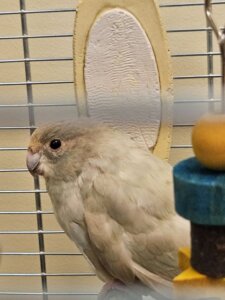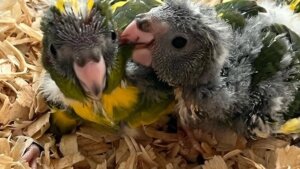Are Kakarikis Cuddly? Discover Their Affectionate Nature
Yes, Kakarikis can be cuddly. These small parrots are known for their playful and affectionate nature.
But, their cuddliness can depend on individual birds and how they are raised. Kakarikis, also known as New Zealand parakeets, have vibrant personalities and are very active. They are intelligent birds that enjoy interaction with their human companions. Their playful behavior can sometimes translate into cuddles and affection, making them a delightful pet choice.
But, it is important to understand that every bird is unique. Some Kakarikis may be more inclined to cuddle than others. Proper socialization and bonding with your Kakariki can increase the chances of having a cuddly companion. This blog will delve deeper into the cuddly nature of Kakarikis and what you can do to foster a closer bond with your feathered friend.
Introduction To Kakarikis
Thinking about getting a new pet bird? Consider the Kakariki. This small parrot is friendly and curious. Kakarikis make interesting companions with their unique behaviors and vibrant colors. But are Kakarikis cuddly? Let’s explore this delightful bird.
Origins And Habitat
Kakarikis come from New Zealand. They thrive in forests, grasslands, and coastal areas. Their natural habitat provides a varied diet and lots of space to fly. In the wild, they are known for their playful and social nature.
Physical Characteristics
Kakarikis are small to medium-sized parrots. They typically measure about 11 inches in length. Their feathers are bright and colorful. The most common colors are green, yellow, and red.
Kakarikis have strong, curved beaks. This helps them to crack nuts and seeds. Their legs are sturdy, allowing them to climb and explore with ease.
| Characteristic | Description |
|---|---|
| Size | 11 inches |
| Colors | Green, Yellow, Red |
| Beak | Strong and Curved |
| Legs | Sturdy |
Kakarikis also have a distinctive voice. They chirp and chatter, especially when excited. Their vocalizations add to their charm. Understanding these traits helps in knowing what to expect from a Kakariki.
Behavioral Traits
Kakarikis are unique birds with interesting behavioral traits. They are known for their social interactions and playful nature. Let’s explore these traits in detail.
Social Interactions
Kakarikis are highly social birds. They thrive in the presence of their human companions and other birds. These birds enjoy interacting and forming bonds.
Kakarikis often engage in mutual preening. This behavior strengthens their social bonds and shows trust. They also communicate with various sounds, chirps, and whistles.
When kept in pairs or groups, they exhibit playful chases and gentle pecking. These interactions are signs of their strong social nature.
Playful Nature
Kakarikis are curious and playful. They love exploring their surroundings and engaging with toys.
Providing a variety of toys keeps them entertained. Puzzle toys, swings, and ropes are excellent choices. They enjoy activities that stimulate their minds and bodies.
These birds are also known for their acrobatic skills. They climb, hang upside down, and perform flips. Their playful antics are a delight to watch.
Overall, Kakarikis’ playful nature makes them a joy to have as pets. Their curiosity and energy are boundless.
Kakarikis And Human Interaction
Kakarikis, also known as New Zealand parakeets, are vibrant and active birds. They bring joy and energy into any home. Understanding their interaction with humans helps in building a loving bond. These birds are naturally curious and friendly. They thrive on interaction and attention from their owners.
Bonding With Owners
Building trust with a Kakariki takes time and patience. Start by spending time near their cage. Talk to them softly and let them get used to your presence. Gradually, you can offer treats through the bars. This builds trust.
Once they feel safe, they may start seeking your company. Allow them to come to you. Encourage them with gentle words and treats. Handling them gently is crucial. They enjoy perching on your finger or shoulder. Regular interaction strengthens your bond.
Signs Of Affection
Kakarikis show affection in various ways. They may preen you, which means they trust you. They may also chirp or sing when happy. Another sign is their willingness to perch on you.
Some Kakarikis enjoy gentle head scratches. They may nuzzle against your hand. They are more likely to show affection if they feel safe. Observing these signs helps you understand their feelings.
Remember, every Kakariki is unique. Their way of showing affection can vary. Patience and consistent care are key to a strong bond. Enjoy the delightful companionship of your Kakariki!

Credit: www.birdcagesnow.com
Training And Socialization
Training and socializing your Kakariki can build a strong bond. Proper training can make your bird cuddly and friendly. Socialization plays a key role in their behavior. With patience and consistency, you can encourage cuddly behavior in your Kakariki.
Basic Training Tips
Start training in a calm environment. Choose a quiet place with minimal distractions. Use positive reinforcement techniques. Offer treats and praise for desired behavior. Be consistent with your commands and rewards. Short, frequent training sessions work best. Keep sessions around 10-15 minutes long.
Teach basic commands first. “Step up” and “step down” are essential commands. These commands help in handling your bird safely. Use a gentle tone when giving commands. Avoid sudden movements to prevent startling your bird. Patience is key during training.
Encouraging Cuddly Behavior
Spend quality time with your Kakariki daily. Gentle petting can build trust. Focus on the head and neck areas. Many birds enjoy being scratched here. Observe your bird’s body language. Respect their boundaries if they show discomfort.
Offer toys and activities to keep them engaged. A bored bird may become less friendly. Rotate toys to maintain their interest. Socialize your Kakariki with family members. This helps them feel more comfortable with people. The more interaction, the more cuddly they may become.
Use soft, soothing tones when talking to your bird. Your voice can be calming and reassuring. Create a routine to help your bird feel secure. Consistency helps in developing cuddly behavior. A happy, well-socialized Kakariki can become a loving companion.
Creating A Comfortable Environment
Creating a comfortable environment for your Kakariki is essential. This will help them feel safe and happy. A well-planned setup can make them more cuddly and friendly. Here are some tips to ensure your Kakariki has the best home.
Ideal Living Conditions
Kakarikis need a spacious cage to move around. The cage should be at least 24x24x24 inches. They love to explore and need space to fly. Place the cage in a quiet area of your home. Avoid direct sunlight and drafts. Keep the room temperature between 65-75°F.
Use a cage with horizontal bars. Kakarikis enjoy climbing. Add perches of different sizes and textures. This helps keep their feet healthy. Clean the cage regularly. Remove waste and uneaten food daily.
| Item | Details |
|---|---|
| Cage Size | At least 24x24x24 inches |
| Room Temperature | 65-75°F |
| Perches | Different sizes and textures |
Toys And Enrichment
Toys and enrichment are crucial for Kakarikis. They are active and intelligent birds. Provide them with various toys to keep them entertained.
- Chew toys help maintain beak health.
- Foraging toys stimulate their minds.
- Swings and ladders encourage physical activity.
Rotate the toys weekly. This keeps your Kakariki interested. Avoid toys with small parts. These can be a choking hazard.
Enrichment also includes social interaction. Spend time with your Kakariki daily. Talk to them and let them out of the cage. This builds trust and makes them more likely to cuddle.

Credit: www.youtube.com
Health And Wellbeing
Ensuring the health and wellbeing of your Kakariki is vital. Healthy birds are usually more affectionate. They also display their playful side more often. Let’s delve into the key factors of their health and wellbeing.
Dietary Needs
Kakarikis need a balanced diet to stay healthy. Fresh fruits and vegetables are essential. These birds love apples, carrots, and leafy greens. Provide them with a high-quality seed mix. Pellets designed for parrots are also beneficial. Fresh water should always be available. Change it daily to keep it clean.
Common Health Issues
Kakarikis can suffer from several health issues. Respiratory infections are common. Keep their environment clean to prevent this. Watch for signs like sneezing and wheezing. Feather plucking is another concern. It can be caused by stress or poor diet. Ensure they have a stimulating environment. A variety of toys and perches can help. Regular vet check-ups are also important. They can catch issues early and keep your bird healthy.
Kakarikis In Multi-pet Households
Many pet owners wonder if Kakarikis can coexist with other pets. The answer is yes, but it requires careful planning. Kakarikis are social birds, but introducing them to other animals must be done thoughtfully. Below, we explore how to successfully integrate Kakarikis into multi-pet households.
Introducing New Pets
When bringing home a new pet, start with a slow introduction. Allow your Kakariki and the new pet to get used to each other’s presence. Use a barrier like a cage or a pet gate.
- Place the Kakariki’s cage in a common area.
- Let the new pet observe the Kakariki from a distance.
- Gradually decrease the distance over several days.
Supervision is crucial during these early days. Watch for signs of stress or aggression from both pets. Patience is key. Rushing the process can lead to conflicts.
Managing Interactions
Once your pets are comfortable seeing each other, start supervised interactions. Keep sessions short at first. Gradually increase the time they spend together.
- Begin with 5-minute sessions.
- Observe their body language closely.
- Increase interaction time by 5 minutes daily.
Always provide a safe retreat for your Kakariki. This could be a high perch or a separate room. If interactions go smoothly, your Kakariki will feel more comfortable. Make sure to reward both pets for calm behavior.
| Steps | Action |
|---|---|
| 1 | Place the Kakariki’s cage in a common area. |
| 2 | Let the new pet observe from a distance. |
| 3 | Supervise initial interactions closely. |
| 4 | Gradually increase interaction time. |
By following these steps, Kakarikis can thrive in multi-pet households. Always ensure each pet feels safe and secure. This will foster a harmonious environment for all.

Credit: www.reddit.com
Frequently Asked Questions
Are Kakarikis Affectionate Pets?
Yes, Kakarikis can be affectionate pets. They enjoy human interaction and can form strong bonds with their owners. Regular handling and gentle care can enhance their cuddly nature.
Do Kakarikis Like Being Held?
Kakarikis generally enjoy being held. They are social birds and appreciate gentle handling. Holding them regularly helps build trust and strengthens your bond with them.
How Do Kakarikis Show Affection?
Kakarikis show affection by chirping, grooming, and snuggling. They may also follow you around and enjoy sitting on your shoulder.
Can Kakarikis Be Tamed Easily?
Yes, Kakarikis can be tamed with patience and consistency. Regular interaction, gentle handling, and positive reinforcement help in taming them effectively.
Conclusion
Kakarikis can be cuddly, but it depends on their personality. Some enjoy human interaction, while others prefer independence. Building trust with your Kakariki takes time and patience. Handle them gently and observe their reactions. Respect their boundaries to foster a strong bond.
With care and attention, your Kakariki might become a loving companion. Always provide a safe and engaging environment. This encourages their natural curiosity and affection. Keep learning about their needs and behaviors. Your efforts will create a happy, healthy relationship.
Hello Dear, I'm Poli Kolymnia, owner of many birds (including budgies).
With a deep passion for these feathered companions, I'm here to share my expertise and extensive knowledge on birds care.
My articles cover essential topics like diet, housing, care, and health, providing practical tips to help you create a happy and thriving environment for your birds.




